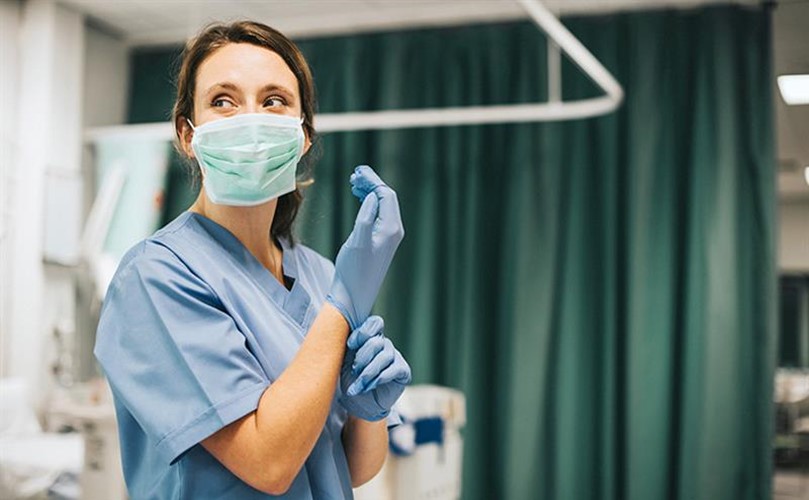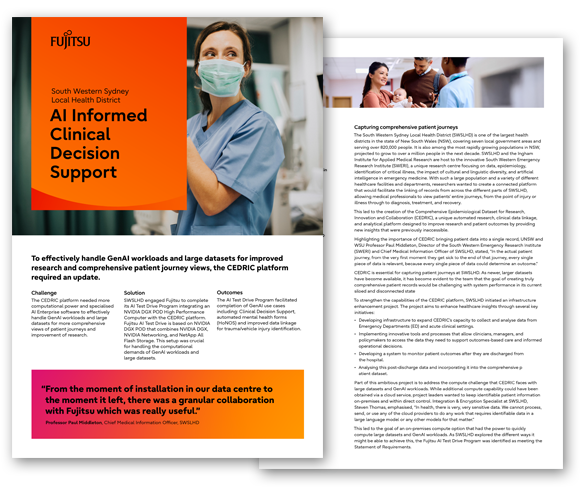South Western Sydney Local Health District AI Informed Clinical Decision Support

To effectively handle GenAI workloads and large datasets for improved research and comprehensive patient journey views, the CEDRIC platform required an update.
Challenges
The CEDRIC platform needed more computational power and specialised AI Enterprise software to effectively handle GenAI workloads and large datasets for more comprehensive views of patient journeys and improvement of research.
Solutions
SWSLHD engaged Fujitsu to complete its AI Test Drive Program integrating an NVIDIA DGX POD High Performance Computer with the CEDRIC platform. Fujitsu AI Test Drive is based on NVIDIA DGX POD that combines NVIDIA DGX, NVIDIA Networking, and NetApp All Flash Storage. This setup was crucial for handling the computational demands of GenAI workloads and large datasets.
Outcomes
The AI Test Drive Program facilitated completion of GenAI use cases including: Clinical Decision Support, automated mental health forms (HoNOS) and improved data linkage for trauma/vehicle injury identification.
“From the moment of installation in our data centre to the moment it left, there was a granular collaboration with Fujitsu which was really useful.”
Professor Paul Middleton, Chief Medical Information Officer, SWSLHD

25m+
patient presentations in CEDRIC Platform
1 NVIDIA DGX POD
- Industry: Healthcare
- Location: Australia
- People: 15,000+
- Customer's website

About the customer
South Western Sydney Local Health District is one of the largest Health Districts in New South Wales. Servicing a population of over 820,000, it covers rural and suburban communities and manages six acute public hospitals and 14 community health centres. Its vision is to provide a healthcare service that is patient focused, equitable and responsive to the changing and developing needs of the communities in South Western Sydney.
The South Western Sydney Local Health District (SWSLHD) is one of the largest health districts in the state of New South Wales (NSW), covering seven local government areas and serving over 820,000 people. It is also among the most rapidly growing populations in NSW, projected to grow to over a million people in the next decade. SWSLHD and the Ingham Institute for Applied Medical Research are host to the innovative South Western Emergency Research Institute (SWERI), a unique research centre focusing on data, epidemiology, identification of critical illness, the impact of cultural and linguistic diversity, and artificial intelligence in emergency medicine. With such a large population and a variety of different healthcare facilities and departments, researchers wanted to create a connected platform that would facilitate the linking of records from across the different parts of SWSLHD, allowing medical professionals to view patients’ entire journeys, from the point of injury or illness through to diagnosis, treatment, and recovery.
This led to the creation of the Comprehensive Epidemiological Dataset for Research, Innovation and Collaboration (CEDRIC), a unique automated research, clinical data linkage, and analytical platform designed to improve research and patient outcomes by providing new insights that were previously inaccessible.
Highlighting the importance of CEDRIC bringing patient data into a single record, UNSW and WSU Professor Paul Middleton, Director of the South Western Emergency Research Institute (SWERI) and Chief Medical Information Officer of SWSLHD, stated, “In the actual patient journey, from the very first moment they get sick to the end of that journey, every single piece of data is relevant, because every single piece of data could determine an outcome.”
CEDRIC is essential for capturing patient journeys at SWSLHD. As newer, larger datasets have become available, it has become evident to the team that the goal of creating truly comprehensive patient records would be challenging with system performance in its current siloed and disconnected state.
To strengthen the capabilities of the CEDRIC platform, SWSLHD initiated an infrastructure enhancement project. The project aims to enhance healthcare insights through several key initiatives:
- Developing infrastructure to expand CEDRIC’s capacity to collect and analyse data from Emergency Departments (ED) and acute clinical settings.
- Implementing innovative tools and processes that allow clinicians, managers, and policymakers to access the data they need to support outcomes-based care and informed operational decisions.
- Developing a system to monitor patient outcomes after they are discharged from the hospital.
- Analysing this post-discharge data and incorporating it into the comprehensive patient dataset.
Part of this ambitious project is to address the compute challenge that CEDRIC faces with large datasets and GenAI workloads. While additional compute capability could have been obtained via a cloud service, project leaders wanted to keep identifiable patient information on-premises and within direct control. Integration & Encryption Specialist at SWSLHD, Steven Thomas, emphasised, “In health, there is very, very sensitive data. We cannot process, send, or use any of the cloud providers to do any work that requires identifiable data in a large language model or any other models for that matter.”
This led to the goal of an on-premises compute option that had the power to quickly compute large datasets and GenAI workloads. As SWSLHD explored the different ways it might be able to achieve this, the Fujitsu AI Test Drive Program was identified as meeting the Statement of Requirements.
The AI Test Drive Program is designed to trial the latest, purpose-built AI infrastructure with 100% control and use of your own data for curation, ingestion and cleaning. The program appealed to SWSLHD as it enabled SWSLHD to test the latest High Performance Computing in an environment that aligned with SWSLHD’s stringent security requirements.
The AI Test Drive Program gave SWSLHD full control and access to a pre-configured NVIDIA DGX system, including 8×A100 GPUs. Fujitsu assisted with the relocation and installation of the NVIDIA system in the health district’s data centre and provided advice on storage architecture and methodology for the DGX platform to ensure the SWSLHD team was able to achieve optimal performance during the test drive experience.
As noted by Thomas, “SWSLHD was already heavily using containers, and the DGX system allowed us to expand on this by leveraging NVIDIA CUDA (Compute Unified Device Architecture) and open-source Large Language Models.”
Comprehensive patient data yielding more treatment success
The AI Test Drive Program delivered measurable, successful outcomes for SWSLHD. Dr. Jim Basilakis, Senior Researcher at SWERI, said, “The availability of the NVIDIA DGX POD allowed us to significantly accelerate our GenAI agenda surrounding clinical decision support and analysis of hospital datasets for SWSLHD.” Through testing the new possibilities in compute speed and power, SWSLHD and SWERI have been able to judge the extent of increased potential it can gain through using this powerful, new technology.
Some of the use cases tested include: the use of Natural Language Processing to accelerate the completion of medical mental health forms by clinicians, simplification of clinical triage notes, anonymisation of electronic health records, and automation of clinical coding for hospital discharge summaries.
“The most valuable benefit was enabling processing and fine-tuning of Large Language Models on very large volumes of fully anonymised hospital records in the order of minutes to hours rather than days to weeks,” Basilakis explains.
The ED stands to benefit significantly from these Clinical Decision Support advancements. Professor Middleton explained that the time-constrained environment of the ED often necessitates a traditionally reductionist approach to care, which can limit the ability to fully understand individual patient needs. Middleton noted that implementing this technology offers significant advantages in personalising care for patients within the ED: “From the time they get sick to the time they get better, we can look at patients as individuals and work out what the influences are, what the predictors are, and what the things we have to do are that are most successful to make sure they get better, and that’s such a revolution in how we deliver care.”
The AI Test Drive Program has enabled the SWSLHD team to research, plan and imagine improved care experiences and outcomes for health professionals and citizens of South Western Sydney.
Related Customer stories




